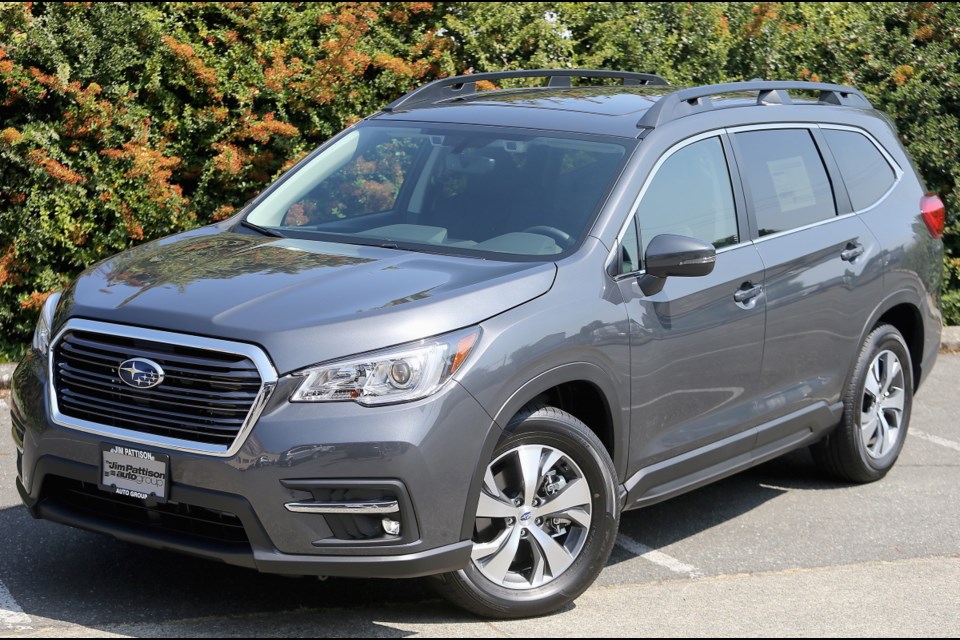In the Cambridge English Dictionary, the word ascent is defined as “a slope, path or road that goes up.” It is perhaps fitting that Subaru has used the word to name its newest, and biggest, SUV.
The new 2019 Ascent fills the three-row seating void left by the discontinuation of the Subaru B9 Tribeca, which left our shores back in 2014.
The mid-sized Ascent is a seven- or eight-passenger SUV based on Subaru’s new Subaru Global Platform, first seen on the 2017 Impreza. The platform is expected to underpin the rest of the Subaru line and accommodate a variety of powertrains, including hybrid and fully electric designs.
The Ascent comes in six trim levels, starting at $35,995 for the base model, called the Convenience. I drove a Touring model with captain’s chairs in the second row, with a price of $41,495.
The Ascent battles against the Volkswagen Atlas, Mazda CX-9, Honda Pilot and others that have entered this popular segment.
Its size gives it considerable storage potential. There are 498 litres of cargo capacity even with all the seats occupied — that’s enough for a couple of hockey or golf bags. If you need more, you can drop the 60/40 third row seats and (in my case) both the captain’s chair backs for long items up to two metres long. With all seats folded, the Ascent can carry up to 2,449 litres of cargo.
The Ascent features a boxy body, which is an advantage when it comes to delivering room for rear passengers, especially those in the rearmost seats. The best part is that the people in the third row won’t have to ride with their knees around their ears.
A word of caution: The centre position of the third-row seat is unyielding. It is a seat, but not meant to be used for more than a few blocks.
The vehicle’s cargo cover has its own slot in a underfloor compartment. It comes into use only if the rear seats are folded.
The Ascent can be configured with either a 60/40 second-row bench seat or two captain’s chairs.
The captain’s chairs made it really easy to access the back seats. The chairs also could slide forward and backward to suit people or cargo preferences, or to ease access to the rearmost seats.
The design of the doors deserve mention — they are large, giving a wide doorway for easy ingress and egress. The lower part of the door covers the sills, keeping them clean. The sills are wide as well, allowing owners to use them as steps to reach items mounted on the standard roof rack (maximum 80-kilogram load).
The rear passengers are pampered with second-row climate control, complete with heated rear seats. The third-row occupants have USB power ports for their electronic devices.
The Touring trim comes standard with a panoramic glass sunroof that spans the whole roof of the car.
The Ascent comes with an impressive driver-assist package, even in the least-expensive model.
The suite includes pre-collision braking (at lower speeds it can stop the car independently). With Subaru’s pre-collision throttle management, the vehicle monitors objects in front of you. If you mistakenly put the vehicle in Drive instead of Reverse, it will reduce throttle sensitivity to help you avoid you accelerating into the object (usually a store front in a shopping mall or the car parked in front of you).
If you back up and don’t stop in time, the car will automatically apply the brakes to avoid a collision with an object, which can be a person (the stop can be quite jarring if you are not ready for it).
Subaru has turbocharged their 2.4-litre four-cylinder engine, giving it 260 horsepower and 277 foot-pounds of torque. It is mated to a continuously variable automatic transmission and full-time all-wheel drive. (Most competitors use on-demand AWD and operate as a front-wheel-drive vehicle the majority of the time.)
The Subaru boasts an impressive 2,270-kilogram towing capacity, thanks to a transmission oil cooler.
All models also come equipped with steering-wheel-mounted paddle shifters.
The Ascent is not a boulevard SUV, with an impressive 220 millimetres of ground clearance. The vehicle comes with Subaru’s X-Mode, which simulates low-range gearing, and there is a hill-descent control as well.
The Ascent is the right vehicle for Subaru loyalists who have outgrown their Forester or for people with large families wishing to find out what all the buzz about Subaru is all about.
While the name implies an upward journey, the Ascent is ready, willing and able to take families on any trek, on and off the beaten path — or just in the urban jungle.
THE SPEC SHEET
Type: Mid-sized seven or eight-passenger SUV, front engine, all-wheel-drive
Engine: Turbocharged 2.4-litre horizontally-opposed four-cylinder engine, 260 hp at 5,600 r.p.m., 277 lb.-ft. of torque at 2,000 to 4,800 r.p.m.
Transmission: Continuously variable
Dimensions (mm): Length, 4,998; width, 2,176; height, 1,819; wheelbase, 2,890
Curb weight (kg): 2,088
Price (base/as tested): $41,495/ $43,395 (includes $1,800 freight and PDI and $100 AC tax)
Options: Nil
Tires: 245/60 R18 on alloy wheels
Fuel type: Regular
Fuel economy (L/100km): 11.6 city/ 9.0 highway
Warranty: Three years/60,000 km new car, five years/100,000 km powertrain and roadside assistance


